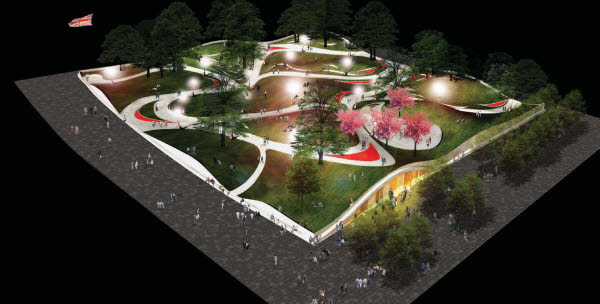
1
1. Perry Kulper’s drawing is a particularly rich exploration of landscape at a strategic level. The contoured topography gives rise to a poetic interpretation that appears to be part landscape and part emerging construct. The drawing overlays the plan of the real landscape with a delicate, layered set of lines and tones. This image operates at two levels: first, there is an overall arrangement of boundaries and surfaces, drawn in dark pencil on Mylar and potential enclosures are emphasized in Naples Yellow, pinks, and Sienna Earth; second, there is an intricate world of detail that negotiates boundaries between the constructed and the explicit landscape, visible through the translucent surface of the Mylar. The layering of the drawing in this way expresses a depth of landscape and at the same time presents the image as a vehicle for imaginative interpretation. This kind of drawing is only in part a conveyor of information; it is also a drawing that provokes reflection about landscape and architecture.

2
2. Perry Kulper’s exploration of the boundaries between architecture and natural context in plan is illustrated three-dimensionally in the “digital paintings” of A E Lee. The important shift in Lee’s work is that the impact of the landscape is caught as a space—a habitat that is part internal and part external. His approach to drawing is pictorial, carefully adjusting color balance, brightness, and contrast to maintain detail but also to attune shadows in order to maintain depth. The drawing starts with a three-dimensional digital model that is carefully assigned lighting and material. Several renders are done using different settings. After importing these layers into Photoshop, they are overlaid and tested using different effects, blending modes and transparencies.

3
3. Gillian Lambert’s drawing of the entrance elevation for the House at Galleon’s Reach is equally evocative of structure and landscape at a river’s edge. The drawing is an imaginary vision that is intended to capture the magical qualities of atmosphere. Studies of wind, captured in sketches, photographs, and line drawings, were edited and used in the final drawing, both compositionally and graphically. The entrance elevation receives southwesterly prevailing winds, and its curtain wall was made of parachute silk. Layers of pencil drawings and paint applied with an airbrush were scanned and combined to build up the blurred and ghostly fabric.

4
4. Stephenson Bell’s rendering of their proposal for a visitor and education center at the Messel Pit, near Frankfurt, (a UNESCO World Heritage Site) is equally evocative, and maintains a high level of detail and clarity. As part of the development of the scheme, the architects visited the site and undertook a photographic study with a Canon 350D digital camera. The muted palette of the snow-covered landscape was emphasized by converting the images into black and white, with the contrast and brightness adjusted (so that all the images were consistent). They were then “stitched” together with Photoshop to create a continuous background for the computer render of the proposed building. The background images were faded out at the perimeters to blend in with the sky and ground.
The proposal was modeled with 3ds Max and rendered with V-Ray, with the camera angles being set up early to enable the background and foreground to be developed while the model was being created. Textures were taken from existing elements on the site photographs (which were adjusted in Photoshop to avoid any repetitive tiling). Particular attention was given to the lighting to achieve a soft diffuse light, replicating the winter haze apparent in the site photographs. The ground levels were modeled to form the right shadows when the ground falls away from the projecting walkway, and together with the soft light the appropriate shadows were created.


5b

5c
5a, b, c. The plan and view of Queen’s Walk, London, (in winter) by West 8 has a similar delicacy in the way that the landscape is rendered. The images combine clarity with a visual impression of the character of the landscape proposal. By contrast there is a more diagrammatic feel to the isometric view (at night) of the overall proposal.
